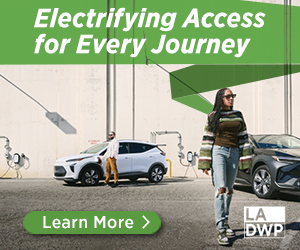Comments
GREEN SCENE - Technological advances have resulted in profound improvements, so important in fact that our quality of life has been hugely upgraded, from wellness to entertainment, to the electrification of transportation. Today the replacement of fuel-powered vehicles with those powered by electricity is not only a major evolution but an obligation.
However, Governor Gavin Newsom gave in to Trump and California will abandon EV tax credits at the end of September, in spite of Newsom`s loud pronouncements to stand up to Trump. And the Governor found a scapegoat and now he blames GM`s CEO Mary Barra for "sold us out" on electric vehicle policies and federal subsidies.
Meanwhile he just signed legislation that fast tracks the approval of 2,000 new oil wells per year over the next decade in Kern County.
Electrifying vehicles, from personal ones to buses in our public transportation systems, and to commercial fleets, is correctly being presented and promoted as our “green solution.” It is a factual misfortune that the transportation sector is a major contributor to greenhouse gas emissions from the burning of gasoline and diesel in internal combustion engines, directly contributing to climate change and numerous public health implications.
Electric vehicles represent a significant shift in transportation technology. The energy landscape will be significantly affected, underscoring the importance of renewable energy integration into the electric vehicle ecosystem. This needed change will also play a vital role in aligning with environmental, social, and governance principles, known widely as ESG. Companies, small and big, are judiciously aiming to meet their ESG targets and net-zero goals—effectively accomplished through electrifying fleets used for transporting people or goods, those owned directly or indirectly by their contractors.
But new speed bumps have appeared on the roadway. President Donald Trump signed three resolutions barring California from mandating electric vehicle sales and setting tailpipe emissions standards designed to stimulate the transition away from combustion engines.
The state’s landmark decision to ban new gasoline-powered cars sales by 2035 is now in jeopardy, along with the revocation of the federal waiver that allows the state to set its own stricter tailpipe emissions. Seventeen states representing 30% of the U.S. vehicle market had also adopted the California plan. Also facing undoing is California’s plan to require a rising number of zero-emissions heavy-duty truck sales.
I see mass adoption of electric vehicles in the Los Angeles Region, in concurrence with a rapid-charging infrastructure rollout and fleet conversions.
Antelope Valley Transit Authority was the first agency in North America with all-electric bus fleet. Three transit agencies in Southern California plan to have an all-electric bus fleet by 2030: Santa Monica, Long Beach and Los Angeles Department of Transportation .LA Metro currently operates forty-five electric buses. The Orange Busway (G Line) operates with all-electric bus fleet. The Los Angeles Unified School District is planning to operate 180 electric buses by 2026, according to Christos Chrysiliou, FAIA, director of architectural and engineering services. Forty of them will have vehicle-to-grid capabilities, meaning that when they are not on the road, their massive batteries will be used to store energy and send it back to the grid when needed.
Yet, it is important to emphasize that with the advancement of technology societal changes must also take place. I have long stressed that embracing innovation while prioritizing sustainability and safety will be significant for cities aiming for efficient transportation networks.
Transportation electrification is an extensive application with many promises. Agencies in the greater Los Angeles area and the rest of Southern California have been front-runners in integrating transportation technologies and pioneering innovative solutions. For example, the city’s electric-vehicle-sharing program; Metrolink’s Southern California Optimized Rail Expansion capital improvement program that integrates Intelligent Transportation Systems and Clean Air Vehicles; the Los Angeles County Metropolitan Transportation Authority’s microtransit service; San Bernardino County Transportation Authority’s hydrogen-powered passenger train; Southern California Edison’s Charge Ready Program; and finally a Mobility-as-a-Service study in 2021 by the Southern California Association of Governments which looked at obstacles and actions towards a fully integrated mobility solutions platform.
Then there are Intelligent Transportation Systems which refer to the application of advanced technologies—including computers, electronics, and communication in transportation systems. The goal is to improve transportation safety, efficiency, and sustainability. This includes traffic management software, real-time traffic data collection and analysis, adaptive traffic signals, electronic toll collection, and advanced traveler’s information products. The system has been popular in recent years and has become a preferred tool to integrate multiple transportation modes and travelers’ information, manage real-time traffic and incidents, and determine dynamic pricing for toll lanes.
Also, a concept that integrates various forms of transportation services into a single accessible on-demand mobility package is called Mobility as a Service (MaaS). By combining numerous services, such as public transport, ridesharing, car-sharing, bike-sharing, and taxis, it allows users to plan, book, and pay for multiple transportation types within a single application and with integrated payment systems.
Additionally, the Smart Columbus project in Columbus, Ohio, is one of the most famous and well-regarded examples of MaaS in the nation. The development of MaaS in America is not as advanced as in East Asian countries. Contributing factors include a preference for car use, limited acceptance of public transit, varying regulatory landscapes, cybersecurity, and data-sharing concerns, and limited central support.
A demand-responsive transport service is known as Microtransit, and it operates in shared passenger vehicles. Unlike fixed-route public transit services such as buses or trains, Microtransit services use smaller vehicles (vans or shuttles) and do not follow a fixed route or schedule. Instead, they adjust routes based on user demand, often facilitated by a digital platform (like an app). Microtransit services provide more flexible and efficient transportation options, especially for first/last-mile connectivity and in areas with lower population density. But it is a haphazard situation, depending on the geographical location, travel behavior, and operations management. And it can be expensive to operate. So, while this is a good technological addition, tailored evaluation will be needed to respond to the local realities.
Advanced vehicles equipped with technologies that enable them to communicate with other vehicles, transportation infrastructure, and external systems, as well as having the capability to operate without human input, are known as Connected and Automated Vehicles (CAVs). The available connectivity allows for real-time data exchange, thus improving safety, traffic efficiency, and environmental sustainability. Automation ranges from partial (where the driver still controls the vehicle but is assisted by technology), to full, where the vehicle operates without any human intervention. An example of this exists in Orlando, Florida. In August 2023, the city’s Lynx transit system launched a six-month pilot project in which two automated shuttle buses provided free service during off-peak hours on part of its Orange Line.
Unquestionably, technology can provide a healthier future for us. Obstacles placed in the way of transportation electrification, and common sense, can drive us backwards to a deleterious and chaotic environmental past.
--
(Nick Patsaouras is an electrical engineer and former Metro board member. Parts of this article are drawn from his book "The Making of Modern Los Angeles". Nick is a featured writer for CityWatchLA.com.)






